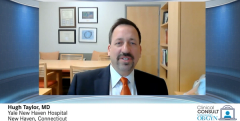
Safety and Efficacy of Elagolix for the Treatment of Endometriosis
Robert N. Taylor, MD, PhD, discusses key findings from clinical trial data on the dosing, pain relief profile, and adverse events of elagolix for patients with endometriosis.
Episodes in this series

Robert N. Taylor, MD, PhD: As I’ve mentioned, we’ve had some pivotal trials now of the GnRH [gonadotropin-releasing hormone] antagonist elagolix, and now that drug is FDA approved and available for the last, I guess, almost 4 years for the treatment of endometriosis pain. Some of the findings of those pivotal clinical trials I think are important to review. The trials were set up looking at 3 types of pelvic pain associated with endometriosis: cyclic pelvic pain, associated with the cycle or dysmenorrhea; noncyclic or nonmenstrual pain, so chronic pain not associated with cycles; and finally, dyspareunia, or pain associated with intercourse. Some of the observations that I think were important are that there’s a dose-responsive effect of these medications on endometriosis-associated pain. The 2 formulations that have been FDA approved are 150 mg once a day, for the low-dose treatment, and 200 mg twice a day, for the high-dose treatment, or 400 mg daily.
Both the adverse effect profile—we’ll talk a little about that as well—as the pain relief profile were dose dependent, as one might expect, given the way these drugs act on the hypothalamic-pituitary-ovarian axis. The adverse effects that were observed were, as one might expect from any medication or any phenomenon that reduces the production of estradiol, vasomotor symptoms or hot flashes, vaginal dryness. There were some modest changes to circulating lipids, again, that we might expect, effects on LDL [low-density lipoprotein] cholesterol, which we know are associated with estradiol levels, and bone loss. The bone loss is dose responsive and in essentially almost all the cases was reversible on discontinuation of the medication, which is the same phenomenon that we’ve seen in the past with Lupron and also with depot progestins. We know that there is some bone loss during therapy that is recovered in most of the cases following discontinuation of the medical therapy. Thus, these were the critical findings and critical adverse effects.
I should point out that in these trials, there were several pregnancies that were reported. The medications have not been associated with any kind of malformations, fetal malformations, or teratogenicity. But it does need to be emphasized that even the high-dose elagolix treatment doesn’t completely suppress ovulation. Thus, clinicians using these drugs need to be aware that some type of effective contraception is really necessary, and that just because these drugs do have the pharmacologic ability to suppress gonadotropins, we can’t rely on them to be a contraceptive agent. Hence, contraceptives need to be used simultaneously.
Transcript Edited for Clarity
Newsletter
Get the latest clinical updates, case studies, and expert commentary in obstetric and gynecologic care. Sign up now to stay informed.













